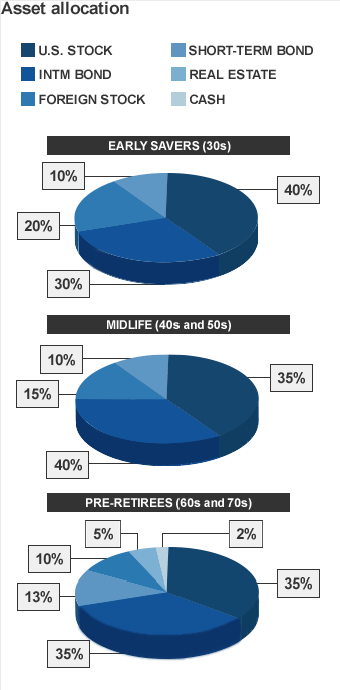1) Focus on what's most important
In achieving wealth, how you invest isn't nearly as important as how much you save.
Say you're 40, have $200,000 saved, with 60% in stocks, and are putting away 10% of a $100,000 salary (including company match). You have a 52% chance of retiring with 70% of your pre-retirement income, according to T. Rowe Price.
Boost your stock stake to 80%, and your chances improve modestly, to 57%. But if you boost your savings to 15% instead, you get to 69%
Message: Stretch to save the most you can.
2) Make a family decision
62% of couples don't agree on their expected retirement age.
The age at which each of you will retire determines how much money you'll need. If you're among the multitude of couples that the Fidelity survey (cited above) found were not on the same page, make some time to talk with your partner about when you'll quit and what you'd like your life to be like.
3) 3 ways to get out of debt
Credit cards are almost never "good" debt, yet professional and managerial workers -- who theoretically should know better -- still carry a median balance on plastic of $3,300, according to the Federal Reserve's most recent Survey of Consumer Finances. Even such a small amount can be deleterious, since you're paying around 15% in interest.
Three ways to get out of the red:
Just pay it off. Behavioral research finds, oddly, that people often save in cash while carrying credit debt. That's a -15% rate on credit vs. 0.13% on savings. See the problem? If you've got enough cash to cover the balance, use it.
Get a 0% card. Interest-free balance-transfer offers are back in a big way. If you think you'd be able to pay off your total debt within 15 months, get one of these cards, and bank what you would have paid in interest.
Break out the tools. Can't pay your debt in 15 months? Use the tools at creditcards.com/calculators to come up with an aggressive schedule to erase the debt. The sooner your IOU is wiped away, the sooner you're back on the wealth-building track.
4) Fill up your 401(k)
Only 12% of 401(k) investors stash away the maximum amount allowed -- $17,000 in 2012 for those under 50 -- reports Vanguard. In fact, the average investor puts in 7.1% of pay, basically just enough to get the employer match.
Need motivation to pump up your percentage?
The value of your retirement plan at 65, starting at 40 with $0 and saving 7.1% of $100,000 salary: $614,000. If you saved the max, the value of your plan at 65 and starting at 40 with $0, would be $1,300,000.
Notes: Assumes 3% annual raises, 7% annualized return, and the 2012 maximum of $17,000.
But also save outside it. Those earning higher wages may need to save more than a 401(k) allows. Next best vehicle: a Roth IRA. The money is saved after tax, so withdrawals in retirement are tax-free. Couples with adjusted gross income up to $173,000 can add $5,000 in 2012 (partial contributions allowed up to an AGI of $183,000). Save the max for 30 years, and you'll net $505,400, assuming 7% annualized returns.
Don't forget to play catch-up. Who says there are no benefits of aging? Folks 50 and up can stash an extra $5,500 in a 401(k) and $1,000 in an IRA per year. But only 32% of those eligible take advantage, according to a TD Ameritrade poll. Too bad, since if you play catch-up on both a 401(k) and IRA each year for a decade, you'll end up with about $96,000 more in your account at 60.
5) Get the mix right
Yes, in 2008-09, investments plunged en masse. But over time assets tend to perform differently. So a diversified mix -- like the to the left, from Rick Ferri of Portfolio Solutions -- reduces risk to keep you on track.
6) Get a pro to help with the plans
Participants in 401(k) plans who receive some form of guidance earn annual returns an average three percentage points higher than those who don't, according to Aon Hewitt and Financial Engines. You may be able to get financial advice for free; an increasing number of companies offer it as a benefit. Ask HR.
In achieving wealth, how you invest isn't nearly as important as how much you save.
Say you're 40, have $200,000 saved, with 60% in stocks, and are putting away 10% of a $100,000 salary (including company match). You have a 52% chance of retiring with 70% of your pre-retirement income, according to T. Rowe Price.
Boost your stock stake to 80%, and your chances improve modestly, to 57%. But if you boost your savings to 15% instead, you get to 69%
Message: Stretch to save the most you can.
2) Make a family decision
62% of couples don't agree on their expected retirement age.
The age at which each of you will retire determines how much money you'll need. If you're among the multitude of couples that the Fidelity survey (cited above) found were not on the same page, make some time to talk with your partner about when you'll quit and what you'd like your life to be like.
3) 3 ways to get out of debt
Credit cards are almost never "good" debt, yet professional and managerial workers -- who theoretically should know better -- still carry a median balance on plastic of $3,300, according to the Federal Reserve's most recent Survey of Consumer Finances. Even such a small amount can be deleterious, since you're paying around 15% in interest.
Three ways to get out of the red:
Just pay it off. Behavioral research finds, oddly, that people often save in cash while carrying credit debt. That's a -15% rate on credit vs. 0.13% on savings. See the problem? If you've got enough cash to cover the balance, use it.
Get a 0% card. Interest-free balance-transfer offers are back in a big way. If you think you'd be able to pay off your total debt within 15 months, get one of these cards, and bank what you would have paid in interest.
Break out the tools. Can't pay your debt in 15 months? Use the tools at creditcards.com/calculators to come up with an aggressive schedule to erase the debt. The sooner your IOU is wiped away, the sooner you're back on the wealth-building track.
4) Fill up your 401(k)
Only 12% of 401(k) investors stash away the maximum amount allowed -- $17,000 in 2012 for those under 50 -- reports Vanguard. In fact, the average investor puts in 7.1% of pay, basically just enough to get the employer match.
Need motivation to pump up your percentage?
The value of your retirement plan at 65, starting at 40 with $0 and saving 7.1% of $100,000 salary: $614,000. If you saved the max, the value of your plan at 65 and starting at 40 with $0, would be $1,300,000.
Notes: Assumes 3% annual raises, 7% annualized return, and the 2012 maximum of $17,000.
But also save outside it. Those earning higher wages may need to save more than a 401(k) allows. Next best vehicle: a Roth IRA. The money is saved after tax, so withdrawals in retirement are tax-free. Couples with adjusted gross income up to $173,000 can add $5,000 in 2012 (partial contributions allowed up to an AGI of $183,000). Save the max for 30 years, and you'll net $505,400, assuming 7% annualized returns.
Don't forget to play catch-up. Who says there are no benefits of aging? Folks 50 and up can stash an extra $5,500 in a 401(k) and $1,000 in an IRA per year. But only 32% of those eligible take advantage, according to a TD Ameritrade poll. Too bad, since if you play catch-up on both a 401(k) and IRA each year for a decade, you'll end up with about $96,000 more in your account at 60.
5) Get the mix right
Yes, in 2008-09, investments plunged en masse. But over time assets tend to perform differently. So a diversified mix -- like the to the left, from Rick Ferri of Portfolio Solutions -- reduces risk to keep you on track.
6) Get a pro to help with the plans
Participants in 401(k) plans who receive some form of guidance earn annual returns an average three percentage points higher than those who don't, according to Aon Hewitt and Financial Engines. You may be able to get financial advice for free; an increasing number of companies offer it as a benefit. Ask HR.




No comments:
Post a Comment